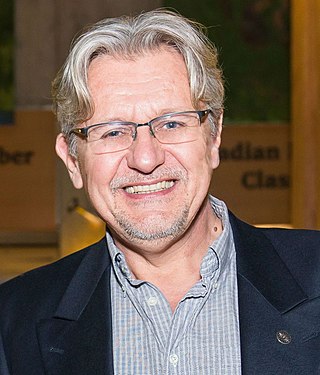Surface modification is the act of modifying the surface of a material by bringing physical, chemical or biological characteristics different from the ones originally found on the surface of a material. This modification is usually made to solid materials, but it is possible to find examples of the modification to the surface of specific liquids.
Scopus is an abstract and citation database launched by the academic publisher Elsevier in 2004.

Carbon fibre reinforced carbon (CFRC), carbon–carbon (C/C), or reinforced carbon–carbon (RCC) is a composite material consisting of carbon fiber reinforcement in a matrix of graphite. It was developed for the reentry vehicles of intercontinental ballistic missiles, and is most widely known as the material for the nose cone and wing leading edges of the Space Shuttle orbiter. Carbon-carbon brake discs and brake pads have been the standard component of the brake systems of Formula One racing cars since the late 1970s; the first year carbon brakes were seen on a Formula One car was 1976.
Differential thermal analysis (DTA) is a thermoanalytic technique that is similar to differential scanning calorimetry. In DTA, the material under study and an inert reference are made to undergo identical thermal cycles, while recording any temperature difference between sample and reference. This differential temperature is then plotted against time, or against temperature. Changes in the sample, either exothermic or endothermic, can be detected relative to the inert reference. Thus, a DTA curve provides data on the transformations that have occurred, such as glass transitions, crystallization, melting and sublimation. The area under a DTA peak is the enthalpy change and is not affected by the heat capacity of the sample.

Polybenzoxazines, also called benzoxazine resins, are cured polymerization products derived from benzoxazine monomers.

Niranjan Krishna Nayak is an Indian aerospace engineer and Professor Emeritus at Indian Institute of Technology Bombay. He is known for his research work on thermomechanical behavior of textile composites and ballistic impact, low velocity impact, fatigue and fracture of composites. His special interest is also on science and technology of aircraft production. Major awards and recognitions conferred to him are: Fellowship of the National Academy of Sciences, India (2004); Fellowship of the Indian National Academy of Engineering (2005); Professor H. H. Mathur Award for "Excellence in Research in Applied Sciences 2006" by IIT Bombay; "Excellence in Aerospace Education Award 2008" by the Aeronautical Society of India; Aerospace Engineering Division Gold Medal of the Institution of Engineers (India) for the year 1992-93 for his research on polymer matrix composites and "Shri Hotchand M. Lala and Shrimati Jamuna H. Lala Excellence in Teaching Award, 2013" by IIT Bombay.
A multi-function material is a composite material. The traditional approach to the development of structures is to address the load-carrying function and other functional requirements separately. Recently, however, there has been increased interest in the development of load-bearing materials and structures which have integral non-load-bearing functions, guided by recent discoveries about how multifunctional biological systems work.
Fibre modification is a research field in which researchers aim at developing and applying technologies to impart new properties to natural fibres such as those in paper, in order to increase their functionality. Research areas in this field include many different technologies, amongst which the chemical modifications of fibres are widely used. One important sector of application of the chemical modifications is the treatment of wood for giving it enhanced properties such as higher mechanical properties, water impermeability, less hygroscopicity, bacterial and fungal resistance. Transferring and adapting the technical knowledge on fibre modification available for the wood sector to the recycled paper sector is an innovative use of these chemical treatments which has been the subject of studies that have been carried out within an EU co-funded project called Fibre+.

Gerhard Alfred Holzapfel is an Austrian scientist, (bio)mechanician. He is currently a professor of Biomechanics and Head of the Institute of Biomechanics at Graz University of Technology, Austria, since 2007. He is also the International Chair of Biomechanics at the Norwegian University of Science and Technology (NTNU), and a visiting professor at the School of Mathematics and Statistics, University of Glasgow, Scotland. He was a professor of biomechanics at KTH Royal Institute of Technology in Stockholm, Sweden, for 9 years until 2013. He is the co-founder and co-editor-in-chief of the international scientific journal Biomechanics and Modeling in Mechanobiology by Springer Nature since the first issue published in June 2002.

Filippo Berto is an Italian professor and engineer, who works on fracture and fatigue mechanics at the Sapienza University of Rome. He is the vice president of the European Structural Integrity Society.

George I. Mantanis is a Greek wood scientist and professor at the University of Thessaly, who is an elected fellow of the International Academy of Wood Science.

Stavros Avramidis is a Greek Canadian wood scientist and professor at the University of British Columbia in Canada, who is an elected fellow (FIAWS) and president of the International Academy of Wood Science for the period 2023-2026.

Roger M. Rowell is an American biochemist and wood scientist of the Forest Products Laboratory at Madison and emeritus professor at the University of Wisconsin-Madison, who is an elected fellow (FIAAM) of the International Association for Advanced Materials and an elected fellow (FIAWS) of the International Academy of Wood Science.

Raymond Allen Young is an American materials researcher, wood scientist and emeritus professor at the University of Wisconsin-Madison, who is an elected fellow (FIAWS) of the International Academy of Wood Science.

Rupert Wimmer is an Austrian materials researcher, wood scientist and professor at the Institute for Wood Technology and Renewable Materials at BOKU University, who is an elected fellow (FIAWS) of the International Academy of Wood Science.

Ruggiero Lovreglio is an Italian academic based in Auckland, New Zealand. He is an associate professor at Massey University and a Rutherford Discovery Fellow for Royal Society Te Apārangi. His research is focused on large-scale and small-scale evacuation dynamics and safety training using emerging technologies, such as virtual reality and augmented reality.
Xiaowen Yuan is a New Zealand materials scientist, and is a full professor at the Auckland University of Technology, specialising in novel composite materials from natural materials for high performance uses, such as improving supercapacitor performance.

Holger Militz is a German wood scientist and professor at the University of Goettingen, who is an elected fellow (FIAWS) of the International Academy of Wood Science.

Peter Niemz (1950) is a German-born Swiss materials engineer, retired wood scientist and emeritus professor of the Institute of Building Materials at ETH Zurich, who is an elected fellow (FIAWS) of the International Academy of Wood Science.
Thomas Rosenau is a German-Austrian chemist and wood scientist specializing in chemistry, who is professor at the Department of Chemistry at BOKU University in Vienna, and also, elected member at the International Academy of Wood Science and honorary recipient of the Anselme Payen Award.













